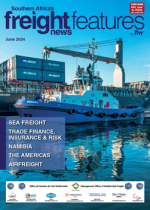Cargo volumes in and out of Namibia continue to grow significantlyon the back of ongoing investment and development in the country.According to Mbahupu H Tjivikua, chief executive officer of the Walvis Bay Corridor Group (WBCG), the group’s proactive approach to business development and trade facilitation has played a pivotal role in attracting new clients and stimulating this increase in cargo volumes. “As a result of these efforts, we have successfully introduced new commodities into the market, including sugar imports from Brazil, as well as exports of coal and copper concentrate,” he told Freight News. “These additions have significantly diversified the range of goods transported through the Walvis Bay Corridors.”He said increased demand for goods in key markets such as Angola, Botswana, the Democratic Republic of Congo (DRC), Malawi, South Africa, Zambia, and Zimbabwe had also contributed to the volume growth. “Noteworthy is the significant expansion in mining activities, particularly in the DRC, Botswana and Zambia, contributing to the increased demand for transport and logistics services.”Tjivikua said an increase in manganese exports via the Port of Lüderitz from the third quarter of this year would further boost volumes out of Namibia. “Volumes will also benefit from the evident shift towards emerging markets, notably in the oil and gas and Green Hydrogen industries, as major multinational corporations strategically establish operations in key locations such as Walvis Bay and Lüderitz. Additionally, Namibia’s growing mining industry, with notable ventures in lithium and uranium, is poised to further boost the demand for transport and logistics services in tandem with these emerging markets.”But, he said, in light of this ongoing growth, more needed to be done regarding infrastructure development and investment into intermodal transport, especially rail linkages and connectivity with neighbouring countries. “Investments are required in truck stops and other related infrastructure along the Walvis Bay Corridors and Walvis Bay and Lüderitz maritime ports. Moreover, the lack of integration in ICT systems, including Single Window, Asycuda and Navis, poses additional challenges to efficient trade facilitation. Recently, the industry has also been experiencing non-tariff barriers related to warehouse bond requirements, car carrier requirements and state veterinary regulations.”According to Tjivikua, Namibia offers many opportunities, particularly for the private sector and potential public-private partnerships. “These opportunities include the establishment of warehouses, distribution centres, cold storage facilities, multipurpose cargo terminals and transhipment facilities, and supply-chain management services. These endeavours are crucial for facilitating the seamless movement and storage of goods within the region.”He said that there were promising prospects within the government’s initiatives to develop Special Economic Zones (SEZs), which are expected to offer various incentives and benefits to investors, further enhancing the country’s attractiveness for business development and investment.

